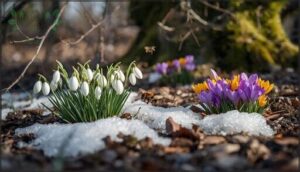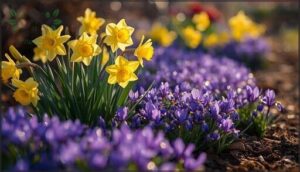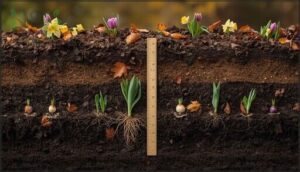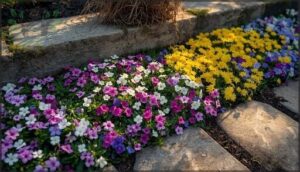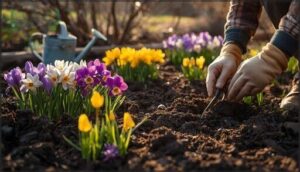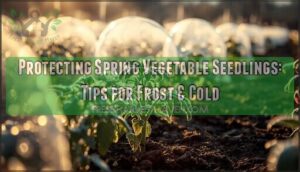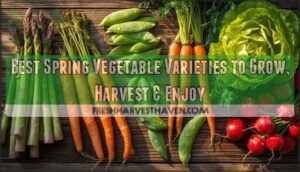This site is supported by our readers. We may earn a commission, at no cost to you, if you purchase through links.
Every year, the first crocus pokes through winter’s crust like a promise kept—small, defiant, and impossibly vivid. It’s not just color you’re craving; it’s reassurance that your spring garden is waking up on schedule, with early blooming flowers leading the charge.
The right mix of bulbs, perennials, and ground covers can transform a cold patch of earth into a tapestry of yellows, purples, and pinks before most folks have packed away their scarves.
Whether you’re plotting bold daffodil drifts or coaxing primrose along a shaded path, spring’s early bloomers set the tone for everything that follows.
Table Of Contents
- Key Takeaways
- Best Early Blooming Bulbs for Spring Gardens
- Top Early Blooming Perennials to Plant
- Early Flowering Shrubs for Spring Impact
- Ground Cover Flowers That Bloom Early
- Planting and Care for Early Spring Blooms
- Frequently Asked Questions (FAQs)
- What flowers bloom the earliest in spring?
- What flowers bloom in February and March?
- When should I start my spring flower garden?
- What are the small purple flowers that bloom in early spring?
- When should I plant spring bulbs?
- How do I divide overgrown bulb clumps?
- Can spring flowers survive late frost?
- What companion plants work with spring bulbs?
- How deep should I plant different bulbs?
- How do companion plants benefit early spring flowers?
- Conclusion
Key Takeaways
- Plant spring bulbs like crocuses, snowdrops, and daffodils at two to three times their height depth in fall (September through October when soil reaches 40–50°F) to ensure they bloom reliably before winter fully retreats.
- Early-blooming perennials such as hellebore and bleeding heart return year after year with minimal maintenance, thriving in shade and requiring division every 2–3 years to maintain vigor and flower production.
- Flowering shrubs like forsythia and dwarf flowering almond provide vertical structure and cascading blooms in early spring, but they must be pruned immediately after blooming—never before—to protect next year’s flower buds.
- Ground covers including creeping phlox and creeping thyme create dense, colorful carpets that suppress weeds, control erosion, and fill gaps between larger plantings while requiring proper spacing (12–18 inches) and consistent moisture to establish quickly.
Best Early Blooming Bulbs for Spring Gardens
Spring-blooming bulbs are your garden’s earliest performers, often pushing through cold soil while snow still lingers in shaded corners. These reliable beauties don’t require much fuss, but choosing the right varieties and planting them at the proper depth makes all the difference.
Let’s look at the standout bulbs that will bring those first welcome splashes of color to your landscape.
Crocus and Snowdrops for First Color
Before most early spring flowers even wake up, snowdrops and crocuses bring the first sparks of color to your garden. Snowdrops push through snow in late January with delicate white bells, while crocuses follow in March with vibrant purple, yellow, and orange blooms.
Plant these small bulbs 3 inches deep and 3 to 4 inches apart for natural clumping, and you’ll create early nectar sources for hungry pollinators. These bulbs naturalize under trees, thriving in areas with less rain and light during the winter months.
Daffodils and Dwarf Iris Varieties
After these first early arrivals, daffodils and dwarf iris steal the show with their bold colors and reliability. Daffodils are divided into 13 official divisions based on flower form—from classic trumpets thriving in zones 3–7 to doubles with extra petals. Plant daffodil bulbs 6 inches deep, dwarf iris 3–4 inches deep, and watch them naturalize into dense, vibrant clumps.
Daffodils, known as the Narcissus genus, are perennials.
- Early cultivars like ‘Rijnveld’s Early Sensation’ bloom by early April
- Dwarf iris reaches just 4–6 inches tall in purple, blue, or yellow
- Both prefer well-drained soil and at least partial sun
- Commercial cultivars reliably return and spread with minimal care
Grape Hyacinth and Glory of The Snow
Right behind iris and daffodils come two powerhouse early bloomers that naturalize beautifully: Grape Hyacinth and Glory of the Snow. These flowering bulbs provide vibrant ground-level color through March and April, attracting pollinators when few other early spring flowering plants are available.
Both thrive as companion plants under roses and shrubs, and their bulb naturalization means they’ll multiply into dense patches with minimal effort.
| Feature | Grape Hyacinth | Glory of the Snow |
|---|---|---|
| Bloom Timing | March–April (zone-dependent) | February–April (often in snow) |
| Height | 8 inches–1.5 feet | 5–35 cm (2–14 inches) |
| Planting Density | 10 bulbs per sq. ft., 3–4 inches apart | Groups of 10–20, spaced 5–10 cm apart |
Planting Depth and Fall Timing
Success with fall bulbs starts beneath the surface. You’ll want to plant spring bulbs at a depth two to three times their height—so a 2-inch bulb goes 4 to 6 inches down. This bulb planting guide protects against frost and anchors strong root growth.
Temperature considerations matter too:
- Plant when soil conditions for bulbs reach 40–50°F consistently
- September through October suits most zones for best emergence and bloom
- Region-specific adjustments push southern areas into November or December planting
Proper fall timing factors and bulb planting depth make sure your spring show arrives on schedule.
Top Early Blooming Perennials to Plant
While bulbs steal the spotlight each spring, perennials offer something even better: they return year after year with minimal fuss. These hardy plants establish deep root systems that allow them to emerge reliably when temperatures warm, often blooming before many gardeners even think about planting annuals.
Perennials quietly outshine spring bulbs, returning each year with reliable blooms and minimal care, even before annuals emerge
Here are four standout perennials that’ll bring your spring garden to life early in the season.
Hellebore and Bleeding Heart Features
If you’re ready to welcome color before winter fully retreats, hellebore and bleeding heart deliver reliably. Hellebores—your Christmas or Lenten roses—stand 12 to 24 inches tall, nodding gracefully in zones 4 to 9, blooming February through May with drought tolerance once established.
Bleeding hearts arch beautifully to 24 inches, returning for decades in zones 3 to 9. Both thrive in shade, resist deer thanks to hellebore toxicity, and need minimal fuss beyond consistent moisture.
| Feature | Hellebore | Bleeding Heart |
|---|---|---|
| Height | 12–24 inches | Up to 24 inches |
| Bloom Time | Feb–May | Spring |
| Hardiness | Zones 4–9 | Zones 3–9 |
| Flower Form | Nodding, cup-shaped | Heart-shaped, arching |
| Special Trait | Deer-resistant, toxic | Rhizomatous, long-lived |
Columbine and Primrose for Spring Interest
For early spring flowers that span weeks of color, columbine and primrose make a winning pair. Columbine blooms 3 to 6 weeks in zones 3–8, offering 1–2 inch flowers in blue, pink, and white that self-seed happily in shade.
Primrose starts even earlier—late January in mild regions—with yellow, magenta, and red blooms lasting up to 4 months when deadheaded, thriving in zones 4–8 with minimal maintenance.
Carolina Jessamine Vine for Vertical Color
If you’re looking for vertical spring color that starts when most gardens still sleep, Carolina Jessamine delivers golden, fragrant blooms from January through April across zones 6–9. This low-maintenance vine climbs 10–20 feet on trellises or arbors, attracting bees and hummingbirds with its jasmine-like scent while providing evergreen foliage year-round.
- Bright yellow flowers appear weeks before most spring blooms
- Drought-tolerant once established, needing minimal care
- All plant parts are toxic—keep away from children and pets
Division and Maintenance Requirements
Most spring perennials thrive when you divide them every 2–3 years, catching them just as new growth emerges. Division timing in early spring gives roots all season to recover before winter stress hits. Post-division care means planting in nutrient-rich soil, watering deeply, and mulching to lock in moisture.
Routine maintenance includes removing dead foliage, thinning crowded clumps for better air circulation, and applying organic matter to boost soil fertility. For pruning specifics, trim spring-blooming shrubs right after flowers fade—never before—to protect next year’s buds. Regular pest control checks help catch problems early when divided plants are most vulnerable.
| Task | When to Do It | Why It Matters |
|---|---|---|
| Divide perennials | Early spring as shoots emerge | Entire growing season for recovery |
| Water deeply | Immediately after division | Aids root development and reduces shock |
| Apply mulch | Post-division and throughout season | Retains moisture, regulates soil temperature |
| Prune shrubs | Right after blooming ends | Avoids removing next year’s flower buds |
Early Flowering Shrubs for Spring Impact
Shrubs bring structure and height to your spring garden, and when they bloom early, they become true showstoppers. These plants offer cascading branches covered in flowers, often before their leaves even appear.
Let’s look at some of the best early-flowering shrubs that’ll give your landscape serious visual impact.
Forsythia and Flowering Quince Selection
When you’re choosing between forsythia and flowering quince for your early blooming season, you’ll want to match each shrub’s traits to your garden’s conditions. Forsythia thrives in Hardiness Zones 5–8, reaching 8–10 feet with vibrant yellow bloom color, while flowering quince grows 6–10 feet in zones 5–8, offering orange, red, pink, or white flowers.
Consider these factors when making your shrub selection:
- Shrub size expectations: Forsythia can spread up to 12 feet; quince stays more compact
- Soil preference: Forsythia tolerates pH 5.0–8.0 and varied textures; quince prefers neutral to slightly acidic
- Cold tolerance: Select ‘Northern Gold’ forsythia for zone 4; standard cultivars need protection below -5°F
- Pruning needs: Both flowering shrubs require post-bloom pruning to maintain shape and encourage blooms
- Bloom timing: Both flower in early to mid-spring before most leaves emerge
Dwarf Flowering Almond and Japanese Camellia
If you want flowering shrubs that offer contrasting bloom timing and flower characteristics, consider dwarf flowering almond and Japanese camellia.
Dwarf flowering almond reaches just 3–5 feet with double pink blooms in late March or early April, thriving in zones 4–9. Japanese camellia, hardy in zones 7–9, displays 2- to 5-inch blossoms from December through March.
Both add early spring blooms but require different climatic tolerance and maintenance needs for your spring garden.
Fothergilla for Fragrance and Form
Fothergilla brings outstanding value to your spring landscape with honey-scented bottlebrush blooms appearing from February through May.
You’ll enjoy these features:
- Compact growth: Dwarf varieties reach 3–6 feet; larger types grow up to 15 feet
- Sweetly fragrant flowers resembling white bottle brushes attract early pollinators
- Multi-season interest with vivid yellow, orange, and red fall color
This native flowering shrub tolerates partial shade while thriving in acidic soil.
Pruning Tips for Spring-Blooming Shrubs
Just as Fothergilla rewards careful attention, flowering shrubs like forsythia thrive with proper pruning timing. Always prune immediately after blooms fade—never before winter. Limit cuts to one-third of growth, focusing on dead wood first. Clean shears matter; sanitized tools lower infection rates. Annual pruning keeps shrubs healthy, while skipping years means fewer flowers and less spring beauty.
| Pruning Timing | After Blooming |
|---|---|
| Method Impact | One-third removal |
| Tool Sanitation | Clean shears |
| Frequency Effects | Annual, not more |
Ground Cover Flowers That Bloom Early
If you want your spring garden to feel lush right from the start, early-blooming ground covers are a smart choice. These plants fill gaps quickly, bringing color and texture to spots that might otherwise stay bare.
Here are some favorites to help you create a carpet of blooms as the season begins.
Creeping Phlox and Vinca Minor
Across early spring flower beds, Creeping Phlox forms vibrant mats that double as top-tier ground cover for Erosion Control and Deer Resistance. Its bloom duration dazzles for three to six weeks, while Vinca Minor, though longer-lasting, needs watchful eyes for its Invasive Potential.
For Cultivar Selection, ‘Candy Stripe’ offers distinct color—ideal for weaving beauty and function into your landscape.
Spring Heath and Sweet Woodruff
If you’re chasing early spring flowers with year-round charm, Spring Heath and Sweet Woodruff deserve a spot in your garden. Spring Heath’s urn-shaped blooms brighten late winter, while Sweet Woodruff’s fragrant foliage weaves a lush, low patch. Both excel in Groundcover Performance, thrive with minimal Maintenance Needs, and offer Ornamental Value that lasts beyond their brief Bloom Period.
- Winter color
- Fragrant foliage
- Low maintenance
- Pollinator support
- Shade tolerance
Creeping Thyme for Pathways and Edges
Along the winding edges of your spring garden, creeping thyme offers Fragrant Pathways and reliable Erosion Control. Short, dense varieties handle light Foot Traffic and thrive in well-drained Soil Requirements, making them excellent ground cover plants for garden design.
While their early spring blooms charm, watch their Invasive Potential—they’ll weave beyond borders if you’re not attentive to their spread.
Establishing Dense Coverage Quickly
When you’re keen for a lush spring flower garden, dense coverage is all about strategy. Early spring ground cover plants thrive with:
- Proper Spacing—12-18 inches speeds up blanket growth.
- Watering Impact—consistent moisture boosts spread by 40%.
- Soil Amendments—organic matter and ideal pH improve root establishment.
Weed suppression and climate compatibility are your secret weapons for lasting spring beauty.
Planting and Care for Early Spring Blooms
Getting your spring garden off to a strong start means paying attention to a few key basics. The right care now sets the stage for healthy blooms when the season arrives.
Here’s what to keep in mind as you plan and plant for early color.
Soil Preparation and PH Requirements
Did you know that soil pH between 6.0 and 7.0 is the sweet spot for spring bulbs? Before planting, test your soil and use limestone or sulfur to adjust as needed.
Mix compost for drainage improvement and nutrient amendments, loosen soil to eight inches deep, and mulch in fall. These soil conditions set the stage for vigorous, healthy plant cultivation.
Sunlight Needs for Different Varieties
Did you know daffodils in full sun can bloom up to 30% larger? Your bulbs crave six hours of direct light, while perennials like hellebores flourish in dappled shade. Forsythia shrubs burst with flowers in full sun, but groundcovers such as vinca minor adapt to partial shade.
Matching soil and light requirements ensures longer bloom duration and vibrant spring color.
Watering and Fertilizing in Early Season
Ever noticed how spring bulbs perk up with just the right watering frequency? Aim for deep, weekly moisture—about an inch—especially if rainfall is scarce. Early morning watering and mulch lock in soil moisture.
Fertilizer types matter: slow-release blends or bulb-specific formulas boost blooming season color.
Adjust for climate shifts; efficient techniques like drip irrigation help meet measured requirements, even in sun or shade.
Protecting Blooms From Late Frosts
Spring can be fickle—one cold snap and those early spring blooms risk frost damage. Frost cloth efficacy is high if you anchor covers to the ground before dusk.
Mulch for insulation shields roots, while watering strategies—moist soil radiates warmth—offer extra protection.
Adjust planting timing and lean on zone-specific recommendations, so your garden weaves through spring’s temperature swings with confidence.
Frequently Asked Questions (FAQs)
What flowers bloom the earliest in spring?
Snowdrops and crocuses are often the first to break winter’s silence, sometimes blooming when snow still lingers.
Bloom timing factors like microclimate influence, regional bloom variations, and species bloom overlap help predict your garden’s earliest spring flowers.
What flowers bloom in February and March?
Isn’t it curious how February Blooms like crocuses and winter-blooming plants often coincide with snow on the ground?
March Varieties—such as hellebores, dwarf iris, and snowdrops—offer considerable frost tolerance and bloom duration, with regional variations shaping their early spring displays.
When should I start my spring flower garden?
You’ll want to begin spring garden preparation in late September to early October, planting spring bulbs and seeds after the last hard frost.
Best timing hinges on soil temperature, chilling period, and regional variations—these guarantee healthy early spring blooms.
What are the small purple flowers that bloom in early spring?
Did you know over 60% of observed spring wildflowers are small purple blooms? Early spring brings Violet Identification, Phlox Varieties, Speedwell Benefits, and Heather Care to the forefront, making wildflower prevalence a dazzling highlight of the blooming season’s flower colors.
When should I plant spring bulbs?
For spring flower bulbs, follow a fall bulb planting guide: plant when soil temperatures dip below 60°F, usually late September to November.
Regional climate impacts timing—early in the north, later in the south—to meet bulb dormancy needs and avoid frost risk.
How do I divide overgrown bulb clumps?
You’ll know overcrowding signs when blooms decline and clumps look congested.
Division timing matters—wait for foliage to yellow, then use a garden fork.
Replant at proper depth to prevent disease and restore vigor.
Can spring flowers survive late frost?
Yes, though it sounds contradictory, coldhardy flowers designed for early spring often survive frost better than you’d expect. Crocuses and snowdrops tolerate freezing, but late frost can delay blooms by six days across most species.
What companion plants work with spring bulbs?
Perennial pairings like hellebore and catmint mask fading bulb foliage, while groundcover benefits include weed reduction and pollinator attraction.
Shrub companions such as forsythia provide visual contrast, ensuring functional outcomes through thoughtful planting considerations in your spring garden design.
How deep should I plant different bulbs?
Think of planting bulbs like layering a cake—get the depth wrong, and nothing rises properly.
Large flower bulbs need six inches in soil, while smaller ones thrive at three to four inches deep.
How do companion plants benefit early spring flowers?
Companion plants draw pollinators to early spring flowers, suppress pests by up to 51%, and improve soil health through nutrient cycling.
They also regulate microclimate conditions and extend color displays by filling gaps after bulbs fade.
Conclusion
A spring garden is a stage—early blooming flowers are your opening act. Plant the crocus, hellebore, and forsythia now, and you won’t wait for warm days to feel the season shift.
Each bulb you tuck into the ground in fall, every perennial you divide in March, builds momentum. The cold retreats, color advances, and your garden proves that patience and planning pay off in waves of yellow, purple, and pink long before summer takes a bow.
- https://www.climate.gov/news-features/event-tracker/first-blooms-2025-spring-season-were-earlier-average-across-most-united
- https://thursd.com/articles/climate-change-plant-flowering-blooming-cycles
- https://www.1800flowers.com/articles/flower-facts/popular-spring-flowers
- https://zerowastehomestead.com/native-spring-ephemerals-of-north-america-the-earliest-blooming-spring-flowers/
- https://www.greenhousegrower.com/management/new-infographic-highlights-economic-impact-of-plants/


